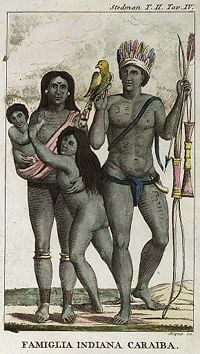Carib
Carib, Island Carib or Kalinago people, after whom the Caribbean Sea was named, live in the Lesser Antilles islands. They are an Amerindian people whose origins lie in the southern West Indies and the northern coast of South America.
Although the men spoke either a Carib language or a pidgin, the Caribs' raids resulted in so many female Arawak captives that it was not uncommon for the women to speak Kalhíphona, a Maipurean language (Arawakan). In the southern Caribbean they co-existed with a related Cariban-speaking group, the Galibi, who lived in separate villages in Grenada and Tobago and are believed to have been mainland Caribs.
History
The Caribs are believed to have left the Orinoco rainforests of Venezuela in South America to settle in the Caribbean. Over the century leading up to Christopher Columbus' arrival in the Caribbean archipelago in 1493, the Caribs are believed to have displaced the Maipurean-speaking Igneri people from the southern Lesser Antilles.
The islanders also raided and traded with the Eastern Taíno of the Virgin Islands and Puerto Rico. The Caribs were the source of the gold which Columbus found in the possession of the Taíno; gold was not smelted by any of the insular Amerindians, but rather was obtained by trade from the mainland. The Caribs were skilled boatbuilders and sailors, and seem to have owed their dominance in the Caribbean basin to their mastery of the arts of war.
The Caribs were themselves displaced by the Europeans, and were eventually all exterminated or assimilated during the colonial period by the Spanish. However they were able to retain some islands, such as Dominica, Saint Vincent, Saint Lucia, and Trinidad.
The Black Caribs (Garifuna) of St. Vincent inherit their ethnicity from a group of black slaves who were marooned in a 1675 shipwreck possibly after seizing power from the crew. In 1795, they were deported to Roatan Island, off Honduras, where their descendants, the Garífuna, still live today. The British saw the less mixed "Yellow Caribs" as less hostile, and allowed them to remain in St. Vincent. Carib resistance delayed the settlement of Dominica by Europeans, and the Carib communities that remained in St. Vincent and Dominica retained a degree of autonomy well into the 19th century.
The last known speakers of Island Carib died in the 1920s. A moderate number of the Haitian, Dominican, and Vincentian populations are reported to have Carib ancestry.
People
Because of Dominica's rugged area, Caribs were able to hide from European forces. Today, on the island's east coast, there is a 3,700 acre territory was granted by the Crown in 1903. There are only 3000 Caribs remaining after many years of brutal treatment by the Spanish, French and British colonists. They elect their own chief. In July of 2003, Caribs Observed 100 Years of Territory. In July of 2004, Charles Williams was elected as Carib Chief. [1] It is said that they are the only remaining native Carib people. However, some of them are married with the local population.
There are several hundred ethnic Caribs in Trinidad, as well as a Carib population in St.Vincent-the size of which is not known. Some ethnic Carib communities remain on the South American mainland, in countries such as Venezuela, Colombia, Brazil, French Guiana, Guyana and Suriname. The sizes of these communities differ.
Religion
The Caribs are believed to have been polytheists.
Patriarchy
Early Carib culture, as seen from a distance, appears especially patriarchal. Women carried out primarily domestic duties and farming, and in the 17th century lived in separate houses (a custom which also suggests South American origin) from men.
However, women were highly revered and held substantial socio-political power. Island Carib society was reputedly more socially egalitarian than Taíno society. Although there were village chiefs and war leaders, there were no large states or multi-tiered aristocracy. The local self-government unit may have been the longhouse dwellings populated by men or women, typically run by one or more chieftains reporting to an island council.
Cannibalism
The English word cannibal originated from the Carib word karibna ('person') – as recorded by Columbus as a name for the Caribs.
Instances of cannibalism are said to have been noted as a feature of war rituals, the limbs of victims may have been taken home as trophies. While the Kalinago would chew and spit out one mouthful of flesh of a very brave warrior, so that his bravery would go to him, there is no evidence that they ate humans to satisfy hunger. The Kalinago also had a tradition of keeping the bones of their ancestors in their houses which had been initially taken as evidence that they ate human flesh.
Missionaries such as Pere Jean Baptiste Labat and Cesar de Rochefort described the Kalinago practice of preserving the bones of their ancestors in their houses in the belief that the ancestral spirits would look after the bones and protect their descendants. Today a similar practice to this is still practiced in tribes of the Amazon.
Even after Columbus was presented with evidence that the cannibalism of the indigenous people was a myth, the myth was perpetuated because in 1503, Queen Isabella ruled that only people who were better off under slavery (including cannibals) could legally be taken as slaves, this provided Spaniards an incentive and legalistic pretext for identifying various Amerindian groups as cannibals in order to enslave them and take their lands away from them.
To this day the Kalinago people fight against what they regard as a misconception about their ancestors. The film Pirates of the Caribbean: Dead Man's Chest was recently criticised by the National Garifuna Council for portraying the Carib people as cannibals.
